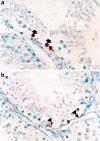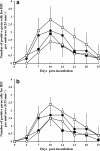Comparative pathogenesis of type 1 (European genotype) and type 2 (North American genotype) porcine reproductive and respiratory syndrome virus in infected boar
- PMID: 23687995
- PMCID: PMC3663669
- DOI: 10.1186/1743-422X-10-156
Comparative pathogenesis of type 1 (European genotype) and type 2 (North American genotype) porcine reproductive and respiratory syndrome virus in infected boar
Abstract
Background: Porcine reproductive and respiratory syndrome virus (PRRSV) now has two main genotypes, genotype 1 (European) and genotype 2 (North American). There is a lack of data on the comparison of pathogenicity of the two genotypes in boars. The objectives of the present study were to evaluate the amount of PRRSV present in semen over time and compare the viral distribution and microscopic lesions of type 1 and type 2 PRRSV-infected boars.
Methods: Twenty-four 8-month-old PRRSV-naïve Duroc boars were randomly allocated to 3 treatment groups. The boars in groups 1 (n = 9) and 2 (n = 9) were intranasally inoculated with type 1 or type 2 PRRSV, respectively. The boars in groups 1 (n = 6) served as negative controls. Semen and blood samples were collected up to 35 days post-inoculation (dpi), and necropsies were performed on 14, 21, and 35 dpi.
Results: There were no significant differences in the genomic copy number of PRRSV, microscopic testicular lesion score, number of PRRSV-positive germ cells, or number of apoptotic cells between the type 1 and type 2 PRRSV-infected boars throughout the experiment. Histopathological changes were manifested by the desquamation of spermatocytes and the presence of multinucleated giant cells in seminiferous tubules of both type 1 and type 2 PRRSV-infected boars. The distribution of PRRSV-positive cells was focal; the virus was found in single germ cells or small clusters of germ cells, localized to the spermatogonia, spermatocytes, spermatids, and non-sperm cells in type 1 and type 2 PRRSV-infected boars.
Conclusions: The results of this study demonstrated that two genotypes of PRRSV do not have significantly different virulence toward the male reproductive system of pigs.
Figures







Similar articles
-
Detection and duration of porcine reproductive and respiratory syndrome virus in semen, serum, peripheral blood mononuclear cells, and tissues from Yorkshire, Hampshire, and Landrace boars.J Vet Diagn Invest. 2001 Mar;13(2):133-42. doi: 10.1177/104063870101300207. J Vet Diagn Invest. 2001. PMID: 11289209
-
Identification of porcine reproductive and respiratory syndrome virus in semen and tissues from vasectomized and nonvasectomized boars.Vet Pathol. 1998 Jul;35(4):260-7. doi: 10.1177/030098589803500404. Vet Pathol. 1998. PMID: 9684969
-
Effect of the modified live porcine reproductive and respiratory syndrome virus (PRRSV) vaccine on European and North American PRRSV shedding in semen from infected boars.Clin Vaccine Immunol. 2011 Oct;18(10):1600-7. doi: 10.1128/CVI.05213-11. Epub 2011 Aug 10. Clin Vaccine Immunol. 2011. PMID: 21832096 Free PMC article.
-
Porcine reproductive and respiratory syndrome virus (PRRSV) in serum and oral fluid samples from individual boars: will oral fluid replace serum for PRRSV surveillance?Virus Res. 2010 Dec;154(1-2):170-6. doi: 10.1016/j.virusres.2010.07.025. Epub 2010 Jul 27. Virus Res. 2010. PMID: 20670665 Review.
-
The ever-expanding diversity of porcine reproductive and respiratory syndrome virus.Virus Res. 2010 Dec;154(1-2):18-30. doi: 10.1016/j.virusres.2010.08.015. Epub 2010 Aug 27. Virus Res. 2010. PMID: 20801173 Review.
Cited by
-
Commercial PRRS Modified-Live Virus Vaccines.Vaccines (Basel). 2021 Feb 22;9(2):185. doi: 10.3390/vaccines9020185. Vaccines (Basel). 2021. PMID: 33671826 Free PMC article. Review.
-
New insights into the testicular tropism of porcine reproductive and respiratory syndrome virus.Microbiol Spectr. 2025 Apr;13(4):e0296424. doi: 10.1128/spectrum.02964-24. Epub 2025 Feb 19. Microbiol Spectr. 2025. PMID: 39969185 Free PMC article.
-
Concurrent vaccination of boars with type 1 and type 2 porcine reproductive and respiratory syndrome virus (PRRSV) reduces seminal shedding of type 1 and type 2 PRRSV.Can J Vet Res. 2017 Apr;81(2):108-117. Can J Vet Res. 2017. PMID: 28408778 Free PMC article. Clinical Trial.
-
Immune Control of PRRS: Lessons to be Learned and Possible Ways Forward.Front Vet Sci. 2014 Oct 14;1:2. doi: 10.3389/fvets.2014.00002. eCollection 2014. Front Vet Sci. 2014. PMID: 26664910 Free PMC article. Review.
-
Emergence of a virulent porcine reproductive and respiratory syndrome virus (PRRSV) 1 strain in Lower Austria.Porcine Health Manag. 2016 Nov 1;2:28. doi: 10.1186/s40813-016-0044-z. eCollection 2016. Porcine Health Manag. 2016. PMID: 28405454 Free PMC article.
References
-
- Cavanagh D. Nidovirales: a new order comprising Coronaviridae and Arteriviridae. Arch Virol. 1997;142:629–633. - PubMed
-
- Zimmerman JJ, Benfield DA, Dee SA, Murtaugh MP, Stadejek T, Stevenson GW, Torremorell M. In: Diseases of Swine. 10. Zimmerman JJ, Karriker LA, Ramirez A, Schwartz KJ, Stevenson GW, editor. Ames: Wiley-Blackwell Publishing; 2012. pp. 461–486.
-
- Meng XJ, Paul PS, Halbur PG, Lum MA. Phylogenetic analyses of the putative M (ORF 6) and N (ORF 7) genes of porcine reproductive and respiratory syndrome virus (PRRSV): implication for the existence of two genotypes of PRRSV in the U.S.A. and Europe. Arch Virol. 1995;140:745–755. doi: 10.1007/BF01309962. - DOI - PMC - PubMed
-
- Halbur PG, Paul PS, Frey ML, Landgraf J, Eernisse K, Meng X-J, Lum MA, Andrews JJ, Rathje JA. Comparison of the pathogenicity of two US porcine reproductive and respiratory syndrome virus isolates with that of the Lelystad virus. Vet Pathol. 1995;32:648–660. doi: 10.1177/030098589503200606. - DOI - PubMed
-
- Martínez-Lobo FJ, Díez-Fuertes F, Segalés J, García-Artiga C, Simarro I, Castro JM, Prieto C. Comparative pathogenicity of type 1 and type 2 isolates of porcine reproductive and respiratory syndrome virus (PRRSV) in a young pig infection model. Vet Microbiol. 2011;154:58–68. doi: 10.1016/j.vetmic.2011.06.025. - DOI - PubMed
Publication types
MeSH terms
LinkOut - more resources
Full Text Sources
Other Literature Sources

